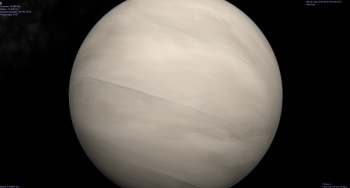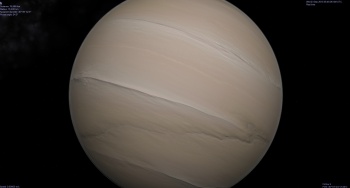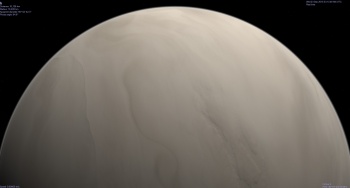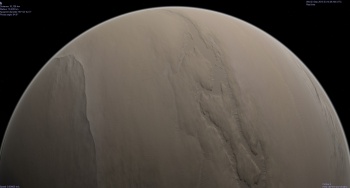Kepler Mission |

  |
Kepler Mission |
 Jul 23 2015, 10:04 PM Jul 23 2015, 10:04 PM
Post
#1216
|
|
 Member    Group: Members Posts: 723 Joined: 13-June 04 Member No.: 82 |
I dunno. 1.6 Earth radii is marginal for Earth-like habitability at best. I've read several papers that indicate that the transition between terrestrial and Neptune-like planets covers a range of radii, not a single value, but that anything over 1.6 Earth radii must definitely be Neptune-like.
If this would be a 1.2 Earth-radii planet, then yes it is probably Earth-like (which includes Venus as an Earth-like planet, of course), but 1.6 Earth radii is probably not. |
|
|
|
 Jul 23 2015, 10:43 PM Jul 23 2015, 10:43 PM
Post
#1217
|
|
 Senior Member     Group: Members Posts: 2530 Joined: 20-April 05 Member No.: 321 |
1.6 Earth radii is marginal for Earth-like habitability at best. I wouldn't expect 1.6 to be "earthlike" at all. More, that since we've seen a healthy ratio of earth-sized planets to Super Earths elsewhere, finding Super Earths here indicates that similar stars almost certainly have earth-sized planets, since there's no magic cutoff that we know of that would allow one and not the other. But this one itself is getting overhyped ("Earth 2.0" is trending on Twitter now). This discovery is really just whittling away at a doubt that nobody really had in the first place. |
|
|
|
 Jul 24 2015, 09:32 PM Jul 24 2015, 09:32 PM
Post
#1218
|
|
 Director of Galilean Photography    Group: Members Posts: 896 Joined: 15-July 04 From: Austin, TX Member No.: 93 |
This discovery is really just whittling away at a doubt that nobody really had in the first place. Yeah, this release really has a "Water detected on Mars!" feel to it. Maybe Emily or another science media member can fill us in with details on why this was significant. -------------------- Space Enthusiast Richard Hendricks
-- "The engineers, as usual, made a tremendous fuss. Again as usual, they did the job in half the time they had dismissed as being absolutely impossible." --Rescue Party, Arthur C Clarke Mother Nature is the final inspector of all quality. |
|
|
|
 Jul 24 2015, 10:05 PM Jul 24 2015, 10:05 PM
Post
#1219
|
|
 Senior Member     Group: Members Posts: 2173 Joined: 28-December 04 From: Florida, USA Member No.: 132 |
... fill us in with details on why this was significant. I'm surprised to find that this announcement is something to complain about!How many other exoplanets of this size with a near earth-year orbit around a sun-like star have been found? Maybe the only complaint is with the use of the term "earth-like". Getting too hung up on that is starting to look like the forbidden Pluto debate. Is Venus earth-like? |
|
|
|
 Jul 27 2015, 08:29 PM Jul 27 2015, 08:29 PM
Post
#1220
|
|
 Senior Member     Group: Members Posts: 2530 Joined: 20-April 05 Member No.: 321 |
I'm surprised to find that this announcement is something to complain about! How many other exoplanets of this size with a near earth-year orbit around a sun-like star have been found? I think this was a case in the familiar category of "Significant but overhyped." It's good to get popular attention, but it's better to get popular attention that isn't misleading. This churned up a lot of references to "Earth 2.0" which is certainly overstating the case. Maybe all PR is good PR, but that's a difficult claim to make objective. At present, the only three attributes we can ascertain of a terrestrial world are radius, mass, level of illumination/heating, and orbital parameters (which may give us a hint about tidal lock). We haven't yet found a close match to Earth, although nobody has reason to doubt that close matches to Earth must certainly exist in vast numbers (i.e., a percentage of all stars, and therefore a vast number per galaxy). Because of observational biases, it's easier to find worlds on the "Hot Jupiter" side of parameter space, and not coincidentally, all of the best earthlike candidates remain significantly more "Hot Jupiter"-like than Earth itself in one or more ways: Bigger, hotter, and/or shorter orbital period. Individual discoveries aren't likely going to change what we already know so long as only those few properties are detectible. It's great to get the public thinking about this stuff as long as we don't produce a "discovery fatigue" by re-announcing the same basic idea over and over, when the discoveries haven't actually changed what we know. When we are able to perform spectroscopy on any of these vaguely (or highly) earthlike planets, or when we find one that's significantly closer than the ones we've found so far, that'll be the next real news in this area. Kepler probably won't contribute directly to either of those investigations. |
|
|
|
 Jul 30 2015, 07:34 PM Jul 30 2015, 07:34 PM
Post
#1221
|
|
|
Member    Group: Members Posts: 890 Joined: 18-November 08 Member No.: 4489 |
just for your viewing pleasure
( if one thinks it is "Earth like" ) youtube 1080 video - K452/b https://youtu.be/-jiipfZDv0I now it might be a BIG Venus or small Neptune'ish thing ????? so...... |
|
|
|
 Jul 30 2015, 08:46 PM Jul 30 2015, 08:46 PM
Post
#1222
|
|
 Member    Group: Members Posts: 555 Joined: 27-September 10 Member No.: 5458 |
Very pleasant John.
Your video did pop a question into my head. How would cloud and weather dynamics be affected with increased gravity on a super Earth analog planet? Could we expect a more rapid weathering process with 'heavier' rain drop and such? -------------------- |
|
|
|
 Aug 1 2015, 12:23 PM Aug 1 2015, 12:23 PM
Post
#1223
|
|
|
Member    Group: Members Posts: 124 Joined: 20-April 05 Member No.: 291 |
Looks like Kepler is going to have its own Pluto observation campaign:
http://www.jpl.nasa.gov/news/news.php?feature=4656 QUOTE Beginning in October, the Kepler spacecraft in its new mission, K2, will train its unceasing gaze on Pluto for nearly three months. Similar to how Kepler detected distant planets by measuring the change in brightness from their host star, K2 will record the change in the reflected light off Pluto and its nearest and largest moon, Charon. Scientists will learn more about the effects on the atmosphere and surface of Pluto imparted by the dwarf planet's eccentric and expanding orbit about the sun. The data may also reveal seasonal changes on this chilly world.
"K2 observations will expand the time coverage of the speedy New Horizons flyby of Pluto, making observations of the dwarf planet-moon system every 30 minutes," said Steve Howell, project scientist for Kepler/K2 at NASA's Ames Research Center in Moffett Field, California. "We are excited to turn the planet-hunting Kepler spacecraft's attention to this distant solar system object to provide additional scientific insight into this far-off, mysterious world, itself a miniature solar system of five moons in orbit about Pluto." |
|
|
|
 Aug 1 2015, 07:19 PM Aug 1 2015, 07:19 PM
Post
#1224
|
|
 Member    Group: Members Posts: 334 Joined: 11-December 12 From: The home of Corby Crater (Corby-England) Member No.: 6783 |
Judging by the number of other observations being undertaken by other craft, Pluto would certainly seem to be the 'Prom Queen' at this time. Just goes to show the importance placed on the NH mission, for what is almost definitely a once in our lifetime encounter.
|
|
|
|
 Aug 4 2015, 05:06 PM Aug 4 2015, 05:06 PM
Post
#1225
|
|
 Senior Member     Group: Members Posts: 2530 Joined: 20-April 05 Member No.: 321 |
now it might be a BIG Venus or small Neptune'ish thing ????? so...... Note that when a planet is discovered by the transit method, we get a measure of its optical radius, but that may or may not correspond to its solid surface. In the solar system, Titan has an optical radius significantly greater than its solid surface, and Venus somewhat less so, but worlds in the "Super Earth" size range may blur the boundary between terrestrial planets and gas giants. So, for two worlds with a radius of, say, 1.4 R[earth], that may be a solid surface in one case, and a high, opaque haze layer in the other case, with significant differences in the size of their respective solid bodies and, conversely, the quantity of bulk (or merely opacity!) in their atmospheres. This could, in principle, be entirely ambiguous from the transit data. It could even remain ambiguous after the mass is known, as the density of terrestrial bodies may also vary by a factor of 3 or so. One of the great advances to hope for is to get a survey of small and mid-sized exoplanets where we start to understand what the ground truth is like given the scant parameters radius, mass, and insolation that we have (in short supply) today. TESS and JWST might advance that a great deal. |
|
|
|
 Aug 4 2015, 06:21 PM Aug 4 2015, 06:21 PM
Post
#1226
|
|
|
Member    Group: Members Posts: 890 Joined: 18-November 08 Member No.: 4489 |
Exoplanets ....... a few data points will be very nice
even a spectral analysis of the atmosphere would help when ever WEBB gets going , maybe we will start getting a few right now for 99% it is mass or radii only but not both |
|
|
|
 Aug 4 2015, 07:54 PM Aug 4 2015, 07:54 PM
Post
#1227
|
|
 Senior Member     Group: Members Posts: 2530 Joined: 20-April 05 Member No.: 321 |
The prospects of measuring the mass of "earthlike" planets using current methods is strained: An earth-mass planet orbiting a sunlike star at ~1 AU doesn't impart much of an acceleration on its star, and is seemingly destined to be lost in the noise. It would be easier with red dwarfs.
If the planet had a detectible satellite, or changed other transiting planets in its own system, that might offer a value. The latter could work with the methods we use now, but requires a lot of luck. |
|
|
|
 Aug 5 2015, 02:53 PM Aug 5 2015, 02:53 PM
Post
#1228
|
|
 Senior Member     Group: Members Posts: 3419 Joined: 9-February 04 From: Minneapolis, MN, USA Member No.: 15 |
In re the question as to whether a 1.6x Earth mass planet could be a rocky planet, vs. if such a planet would become Neptune-like -- wouldn't that depend a lot on the nature of the planetary disk from which the planets formed, where in the system it formed (i.e., inside or outside of the frost line), the dynamics of the other planets in the system, etc.?
I've heard speculation that the migration of Jupiter in and out "stole" some of the material that would otherwise have been available for Mars' accretion, gathering some of that material into itself and scattering the rest into our asteroid belt. So, depending on the dynamics of other planets in the 452b system, as well as the original composition of the planetary disk and the timing of the star's T-Tauri phase (which would have blown gasses out of the inner system) and, of course, the impact of being inside the frost line when you develop enough mass to begin to accrete a large gaseous shell, perhaps it is quite easy to develop a fully rocky planet of the size of 452b without passing over into becoming a Neptune-like object? I think it's a little simplistic to state that all objects above a certain size will become Neptune-like, when Neptune itself is defined by a lot of factors that would not apply if such a body formed far closer to its star than Neptune itself did... -the other Doug -------------------- The trouble ain't that there is too many fools, but that the lightning ain't distributed right. -Mark Twain
|
|
|
|
 Aug 5 2015, 07:52 PM Aug 5 2015, 07:52 PM
Post
#1229
|
|
|
Member    Group: Members Posts: 890 Joined: 18-November 08 Member No.: 4489 |
it is rather unlikely it is a water and plant world
at the time of the announcement i was working on a EARTH mark 2 type procedure hay art is FUN i would really guess it is more of a rocky BIG Venus type planet something more along these lines -- 100% artistic ( 1920 x 1080 px) --     until there is a good MASS guesstimate this or a small WATER cloud gas giant is up in the air QUOTE Your video did pop a question into my head. How would cloud and weather dynamics be affected with increased gravity on a super Earth analog planet? Could we expect a more rapid weathering process with 'heavier' rain drop and such? i would NEED a geologist to run through the numbers but... there are a lot of unknown variables the greater the gravity the more force is applied to the fault zones and the more pressure is applied .So more force will be needed for them to slip -- less quakes but they will be BIG 8 .?+'s so less plate movement ?? maybe ?? bigger mass bigger core , more heat and more turbulence in the core and mantle this might speed up plate movement The greater volume the faster the crust will cool so less plate movement now if there is liquid water the rain WILL hit the ground harder but smaller drops ?? maybe ?? if the atmosphere is rather thick the drops will be bigger because the atmosphere is more buoyant see the problems everything has a yes AND no but it would be nice to see some of the NOAA climate models ran with other world settings and some of the CSDMS Models ran with non earth settings ( h t t p : / / csdms.colorado.edu/wiki/Model_download_portal ) . |
|
|
|
 Aug 5 2015, 08:16 PM Aug 5 2015, 08:16 PM
Post
#1230
|
|
 Senior Member     Group: Members Posts: 2530 Joined: 20-April 05 Member No.: 321 |
Other Doug, it certainly seems possible for a rocky-only world, with about 1.6 RE and no thick atmosphere to exist very close to the star. In fact, it's possible for a gas dwarf consisting of metals and silicates (molten or gaseous) to exist very close to the primary.
The size distribution data from Kepler and other sources suggest that there is no gap in the size distribution, which is interesting given that a catastrophic size increase will occur in situations where a world becomes large enough to retain helium while the nebula still has a lot of hydrogen and helium. That suggests a binary outcome where you get either an Earth or a Neptune, depending upon whether or not the threshold is reached. And perhaps there is such a binary outcome in terms of what kind of world you end up with, but there is no gap in the size distribution, so there must be large rocky worlds with more or less the same size as small mini-giants. When we have more Super Earths where the radius and mass are both known, we can start to understand that. However, finding the mass of Super Earths that are not close to their star will be challenging, so any such understanding may be confined to planets in short orbital periods for quite some time to come. |
|
|
|
  |

|
Lo-Fi Version | Time is now: 29th April 2024 - 11:32 AM |
|
RULES AND GUIDELINES Please read the Forum Rules and Guidelines before posting. IMAGE COPYRIGHT |
OPINIONS AND MODERATION Opinions expressed on UnmannedSpaceflight.com are those of the individual posters and do not necessarily reflect the opinions of UnmannedSpaceflight.com or The Planetary Society. The all-volunteer UnmannedSpaceflight.com moderation team is wholly independent of The Planetary Society. The Planetary Society has no influence over decisions made by the UnmannedSpaceflight.com moderators. |
SUPPORT THE FORUM Unmannedspaceflight.com is funded by the Planetary Society. Please consider supporting our work and many other projects by donating to the Society or becoming a member. |

|